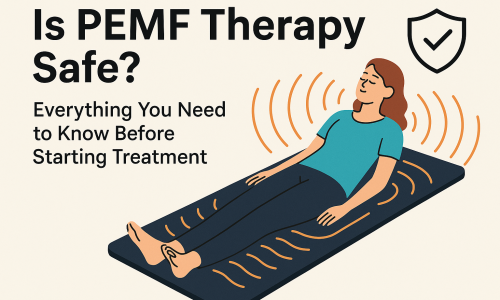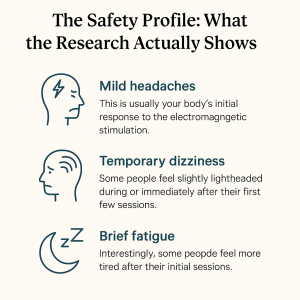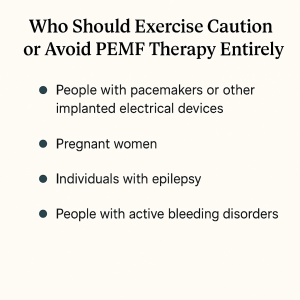
Safety, effectiveness, and peace of mind – these are the key concerns people have when considering any new health treatment, and PEMF therapy is no exception.
As more people discover the potential benefits of Pulsed Electromagnetic Field therapy, one question keeps coming up in conversations with patients and wellness enthusiasts alike: “Is PEMF therapy safe?”
Over the years, I’ve seen this technology evolve from something used primarily in clinical settings to a wellness tool that many people now use at home. But with that growth comes the natural desire to understand the safety profile completely.
In this comprehensive guide, I want to walk you through everything you need to know about PEMF therapy safety. I’ll break down the research, discuss who should use caution, and give you practical steps to ensure you have the safest possible experience.
Before we dive deep into safety considerations, let me give you some context about what we’re actually dealing with when we talk about PEMF therapy.
What Really Is PEMF Therapy?
PEMF therapy stands for Pulsed Electromagnetic Field therapy, and at its core, it’s remarkably straightforward. The technology uses low-level electromagnetic waves to stimulate your body’s cells, potentially supporting your natural healing processes.
Think of it this way: your body already runs on electrical signals. Your heart beats because of electrical impulses, your brain communicates through electrical activity, and your cells naturally carry electrical charges. PEMF therapy works by interacting with these existing electrical processes.
The treatment itself is completely non-invasive – no surgery, no medications, no needles. You simply lie down or sit near a device that generates these electromagnetic pulses. People use PEMF therapy for various reasons, including pain relief, better sleep quality, and faster recovery from injuries.
What makes this particularly interesting from a safety perspective is that this isn’t some brand-new, untested technology. PEMF therapy has been studied and used in medical settings for decades, with certain devices even receiving FDA approval for specific applications like treating bone fractures and managing pain and swelling.
For a deeper dive into how this technology works and its potential benefits, check out our detailed guide on [PEMF Therapy Benefits].
What Research Actually Shows About PEMF
Therapy
When we look at the safety data for PEMF therapy, the picture that emerges is quite reassuring for most people.
Multiple studies conducted over several decades have consistently found PEMF therapy to be a low-risk treatment option. The electromagnetic pulses used are low-level – we’re talking about field strengths that are typically much weaker than what you’d experience from common household electronics.
Here’s what makes many healthcare providers comfortable recommending PEMF therapy: the risk-benefit ratio heavily favors the benefit side for most individuals. The treatment doesn’t involve pharmaceuticals, so you’re not dealing with drug interactions or systemic side effects that can come with medications.
That said, I always tell people that “generally safe” doesn’t mean “universally safe for everyone.” Every person’s situation is unique, and there are definitely some important considerations and precautions we need to discuss.
The key is understanding where you fit in the safety spectrum and taking appropriate precautions based on your individual circumstances.
What Side Effects Could You Experience and Why?
While PEMF therapy has an excellent safety profile, some people do experience mild side effects, especially when they’re first starting treatment.
The most commonly reported side effects include:
1. Mild headaches This is usually your body’s initial response to the electromagnetic stimulation. Think of it like starting a new exercise routine – your body needs time to adapt.
2. Temporary dizziness Some people feel slightly lightheaded during or immediately after their first few sessions. This typically resolves quickly as your system adjusts.
3. Brief fatigue Interestingly, some people feel more tired after their initial sessions. This often indicates that your body is responding to the treatment and beginning repair processes.
Here’s the important thing to understand: these side effects are typically mild and temporary. They usually indicate that your body is adjusting to the therapy rather than signaling any danger.
If you do experience these effects, the standard recommendation is simple: take a break, reduce the intensity of your next session, or shorten the treatment time. Most people find that these initial responses disappear within the first few sessions.
However, there’s one group that needs special attention, which brings us to our next important topic.
Who Should Avoid PEMF Therapy or Exercise with Caution?
While PEMF therapy is safe for the majority of people, there are specific circumstances where caution is necessary or where the therapy should be avoided altogether.
1. People with pacemakers or other implanted electrical devices This is the most critical safety consideration. Electromagnetic fields can potentially interfere with the normal functioning of pacemakers, insulin pumps, cochlear implants, and other electronic medical devices. If you have any implanted device, you absolutely must consult with your cardiologist or device specialist before considering PEMF therapy.
2. Pregnant women While there’s no evidence that PEMF therapy is harmful during pregnancy, there simply isn’t enough research to definitively say it’s safe either. Most healthcare providers recommend avoiding PEMF therapy during pregnancy as a precautionary measure.
3. Individuals with epilepsy Some research suggests that electromagnetic fields could potentially trigger seizures in people with epilepsy. If you have a seizure disorder, it’s essential to discuss PEMF therapy with your neurologist before proceeding.
4. People with active bleeding disorders PEMF therapy may affect circulation and blood flow. If you have hemophilia or another bleeding disorder, or if you’re taking blood-thinning medications, consult with your healthcare provider first.
The bottom line is this: when in doubt, ask your doctor. It’s always better to err on the side of caution, especially if you fall into any of these categories.
Weighting Benefits Against Risks
When I talk to people considering PEMF therapy, they often want to know how the benefits stack up against the potential risks.
From a practical standpoint, most people find that the benefits significantly outweigh the minimal risks. PEMF therapy has demonstrated potential in helping with pain relief, improving sleep quality, supporting faster recovery from injuries, and enhancing overall wellness – all without the side effects commonly associated with pharmaceutical interventions.
The risk profile, as we’ve discussed, is quite low for most people. The minor side effects like temporary headaches or fatigue are manageable and usually short-lived. The more serious concerns – like interference with pacemakers – are easily preventable with proper screening and medical consultation.
For many people, PEMF therapy represents an attractive middle ground: a treatment that’s more substantial than basic lifestyle changes but less invasive and potentially problematic than pharmaceutical or surgical interventions.
If you’re interested in learning more about the specific benefits that make PEMF therapy appealing to so many people, our comprehensive guide on [PEMF Therapy Benefits] covers the research and real-world applications in detail.
Your Roadmap To Safe PEMF Therapy
If you’ve decided that PEMF therapy might be right for you, here’s your step-by-step approach to ensuring the safest possible experience:
Choose the right PEMF mat for your specific needs Not all PEMF mats are created equal, and selecting the right one for your situation is crucial for both safety and effectiveness. Consider factors like intensity levels, frequency ranges, mat size, and specific features that align with your wellness goals. To help you navigate the options and find the perfect match, check out our comprehensive PEMF mat comparison guide that breaks down the key differences between popular models.
Follow recommended guidelines religiously Every PEMF device and protocol comes with specific recommendations for treatment duration, frequency, and intensity. These guidelines exist for good reasons – following them helps ensure both safety and effectiveness.
Listen to your body throughout the process Pay attention to how you feel during and after each session. If something doesn’t feel right, it’s perfectly okay to stop the session and reassess. Your body’s responses are valuable feedback.
Start conservatively and progress gradually Begin with shorter sessions at lower intensities, then gradually work up to the full recommended protocol. This gives your body time to adapt and helps minimize any initial adjustment effects.
The goal is to make PEMF therapy a positive addition to your wellness routine, and taking these precautions helps ensure that happens safely and effectively.
PEMF therapy represents an exciting intersection of established science and modern wellness applications. While it’s not appropriate for everyone, the safety profile for most people is quite encouraging, especially when proper precautions are taken and professional guidance is sought when needed.
Curious to Know What Would Be the Best PEMF or Far Infrared Device for you?
Tap the button below to read a side-by-side comparison of the top mats on the market!
Tap Here!


